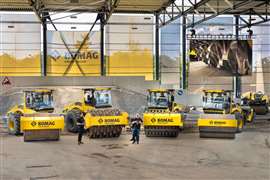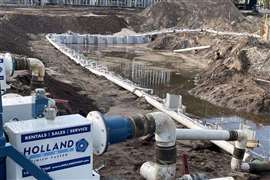Mini vision
23 April 2008
"Hitachi didn't start focusing on rental in Europe 10 years ago", says Joep van den Maagdenberg, sales representative for Hitachi Europe's mini-excavator business, "but we have for the last three or four years. For us, it's a very important part of the market."
If Hitachi's reputation is for premium, quality products, there are now signs that the company is starting to be more flexible in the kinds of machines that it will develop for the European and rental markets.
A telling example is the plan to introduce in October this year a new 1.4-1.5 t class ZX14 model that is being designed specifically with rental in mind. The ZX14, of which the prototype is currently being tested in Japan, will compete head-on with the utility-type minis produced by companies including Kubota, Takeuchi and JCB.
It will be an ‘undressed' machine that will have canopy or cabin options and long and short arm options. The canopy version will be the light version, and the cabin model more of a real 1.5 t class mini. The canopy model will be small enough to be carried by a vehicle such as a Iveco Daily.
Other models in the mini range will also have features that lend themselves to rental, such as pipework necessary for clamshell attachments; an overload relief valve for breaker use; and anti-theft keypad and multi-function operating lever.
The importance of the 1-2 t mini-excavator segment is clear when you look at the sales numbers. In Europe, for example, this segment accounts for over 30% of the +70000 unit excavator market.
Hitachi is at pains to point out that a more proactive approach to rental market will not lead to a reduction in product quality; "We will not devalue the quality of the machines", says Raymond Hendriks, manager of Hitachi's European corporate communications. He does say however that the new ZX14 model is indicative of a shift in attitude; "It's a sign of how important we see rental."
The new 1.5 t class machine will not be the only changes to the range this year. For example, a cabin version of the ZX17-U2 model is now being made, and it may be that this machine will eventually replace the existing conventional ZX16 and 18 models.
This is being made at Hitachi's mini-excavator plant at Oosterhout, which makes machines up to 5 t, with larger models assembled at Hitachi's much bigger and newer facility in Amsterdam. The Oosterhout range comprises zero tailswing ‘U' models made in Japan and conventional models made in-house.
Other mini- or midi- models will also be upgraded to dash-3 status (bypassing any ‘dash-2' machines): this will include the ultra-short tail ZX85US-3/ZX85USB-3 models that will update the existing ZX85US and also replace the non-zero tailswing ZX80SB model. The ZX70, another conventional model, will meanwhile get a new cab.
Another new ultra short tailswing model is the 6 t ZX60USB-3, launched at the Samoter show in early March, that will fill a gap between the existing 6 t and 8 t models, and will become part of the Oosterhout line-up.
The ZX60 has a 40.5 kW engine, an operating weight of between 5990 kg and 6120 kg, a 0.22-0.24 m3 bucket capacity, and maximum digging depth of 4.12 m. The bucket digging force is 41.1 kN.
Hitachi's mini-excavator sales specialist, Joep van den Maagdenberg, tells IRN that the 6 tonner comes with both E and P mode operation: the E mode is for fuel efficient running, and the P mode is the ‘power' setting - a choice that was previously only available on Hitachi's midi-size excavators. Mr van den Maagdenberg adds that the boom uses a single pin connector rather than the two pin system used on some previous models of this size.
If the product line is taking more notice of the rental market, so are the ‘soft' products being offered by the company. Mr van den Maagdenberg tells IRN that Hitachi's finance arm, Zaxis Finance, will play an important part in business with rental companies, as will other services; "For key accounts and big rental companies, there is a different way of doing business. Price is important, but also residual value, service intervals, training - it's an intensive approach. It needs dedicated people who have experience in that market."
It sounds as if the Hitachi super-tanker is changing direction.
=== BOX STORY ===
A shift upwards?
Esther Navest-ten Kroode, head of domestic sales at Hitachi Construction Machinery's Oosterhout mini-excavator facility, says there are signs that rental companies in the Netherlands are looking for larger sized excavators to rent, often without operators.
She says the big Netherlands rental companies like Boels and Bo-Rent have rented minis for years, but that some are now also considering the rental of much larger models.
One example is Rental Force, a company that rents a wide range of Hitachi excavators in the 13 t to 52 t range. Boels has also now entered that market with the acquisition last year of heavy equipment rental specialist De Block-Lambin. Since the acquisition, Boels has ordered a further nine Hitachi machines up to 21 t, to add to De Block-Lambin's existing fleet of 40 Hitachi models.
"Now you see more and more companies doing that", says Mrs Navest-ten Kroode.
=== BOX STORY ===
High volumes
Like other manufacturers Hitachi in Europe has been investing in its production capacity. The new assembly facility that it built in Amsterdam several years ago was significantly increased in size last year with the addition of an adjoining €11 million, 19200 m2 component welding and machining facility that will allow the main building to focus entirely on assembly operations.
Amsterdam is where Hitachi assembles machines using components imported from Japan and elsewhere, and where it also processes fully-built models from Japan. Japanese content is still high, at around 60-65%.
At the start of 2008 production capacity was running at around 18 complete units a day, of which 14-15 are assembled in the facility, with the balance imported complete from Japan. The intention is to increase this capacity to 23 units/day by 2010.
At the mini-excavator facility in Oosterhout, meanwhile, there are moves to increase both local content and production volumes. The zero tailswing models are imported from Japan, with the conventional models made in Oosterhout. Now, however, there are plans for Oosterhout to prepare and mount booms and arms for some of the U models, including the 30U and 35U machines.
Production capacity is also being increased. The facility currently makes 3000 units a year, and the aim is to increase that to 5500 in Europe, partly through an increase in sales of the zero tailswing ‘U' models.
STAY CONNECTED



Receive the information you need when you need it through our world-leading magazines, newsletters and daily briefings.
CONNECT WITH THE TEAM











